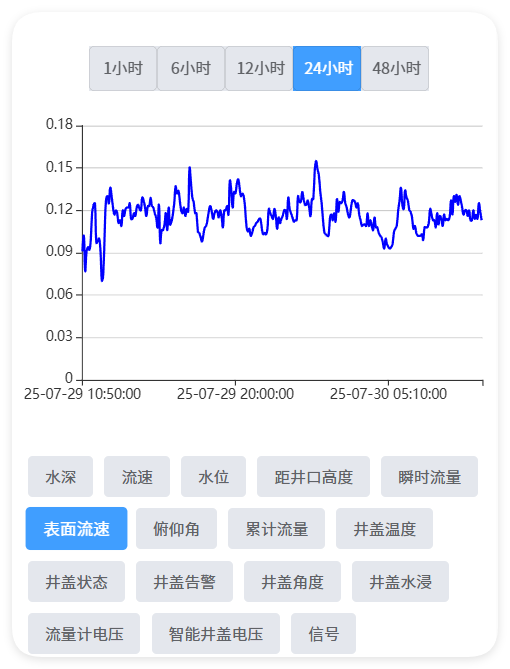文章目录
1.最终效果预览

2.顶部时间选择,中间echart图,底部监测项
<view class="button-group-top">
<button v-for="(item, index) in buttonList" :key="index"
:class="['time-btn', { 'active': currentBtnIndex === index }]" @click="handleClick(index,item)">
{{ item.name }}
</button>
</view>
<view @click="echarts.onClick" :prop="option" :change:prop="echarts.updateEcharts" id="echarts" class="echarts">
</view>
<view class="btn-group">
<view v-for="(item, index) in project" :key="index"
:class="['btn-item', { active: currentIndex === index }]" @click="switchIndicator(index,item)">
{{ item.structName }}
</view>
</view>
3.Echart集成
在uni插件市场找到插件renderjs-echarts-demo,我们运行demo就可以出现一个柱状图,我们基于这个demo改造下我们的项目即可。
<script module="echarts" lang="renderjs">
let myChart
export default {
mounted() {
if (typeof window.echarts === 'function') {
this.initEcharts()
} else {
const script = document.createElement('script')
script.src = 'static/echarts.js'
script.onload = this.initEcharts.bind(this)
document.head.appendChild(script)
}
},
methods: {
initEcharts() {
myChart = echarts.init(document.getElementById('echarts'))
myChart.setOption(this.option)
},
updateEcharts(newValue, oldValue, ownerInstance, instance) {
myChart.setOption(newValue)
},
onClick(event, ownerInstance) {
ownerInstance.callMethod('onViewClick', {
test: 'test'
})
}
}
}
</script>
4.集成网络请求
uni.request({
url: 'xxxx',
data: obj,
success: (res) => {
this.initData(res.data.data)
}
});
在页面中直接用这个网络请求就能拿到数据,不知道为啥将网络请求封装后发反而拿不到数据了,返回的参数多了好几层
5.底部按钮切换调用方法
switchIndicator(index, item) {
this.currentIndex = index
this.getSluiceMoniDataPicitemId(item.siteItemId)
}
getSluiceMoniDataPicitemId(siteItemId) {
let arr = this.project.filter(item => {
return siteItemId == item.siteItemId
})
if (arr && arr.length > 0) {
this.structName = arr[0].structName
}
this.siteItemId = siteItemId;
this.getDataByTime()
}
6.调用接口获取echart数据
getEchartData(obj) {
this.yArr = []
this.xArr = []
uni.request({
url: 'xxxxx',
data: obj,
success: (res) => {
let arr = res.data.data;
for (let i in arr) {
if (arr[i].DATA_TIME) {
this.yArr.push(arr[i].DATA_VALUE)
this.xArr.push(arr[i].DATA_TIME)
}
}
if (this.yArr) {
this.addOption();
}
}
});
}
7.设置echart图的option
addOption() {
this.option = {
grid: {
left: '7%',
right: '5%',
bottom: '11%',
top: '7%',
containLabel: true
},
xAxis: [{
splitLine: {
show: false
},
type: 'category',
boundaryGap: true,
data: this.xArr
}],
yAxis: [{
type: 'value',
splitLine: {
show: true
},
}],
series: [{
name: '',
type: 'line',
stack: '总量',
smooth: true,
symbol: 'none',
areaStyle: {
normal: {
color: 'rgba(255,255,255,0.4)'
}
},
itemStyle: {
normal: {
color: 'rgba(3,169,244,1)'
}
},
lineStyle: {
normal: {
color: 'blue'
}
},
data: this.yArr
}]
}
}
8.顶部时间点击方法
handleClick(index, item) {
this.currentBtnIndex = index
this.btnHourValue = item.value
this.getDataByTime()
}
getDataByTime(){
let tTime = new Date()
let endTimeValue = timeFormat(tTime, 'yyyy-MM-dd HH:mm:ss')
let sValue = tTime.setHours(tTime.getHours() - parseInt(this.btnHourValue)) // value小时前
let startTimeValue = timeFormat(sValue, 'yyyy-MM-dd HH:mm:ss')
let obj = {
'itemMoniId': this.siteItemId,
'startTime': startTimeValue,
'endTime': endTimeValue,
}
this.getEchartData(obj);
}